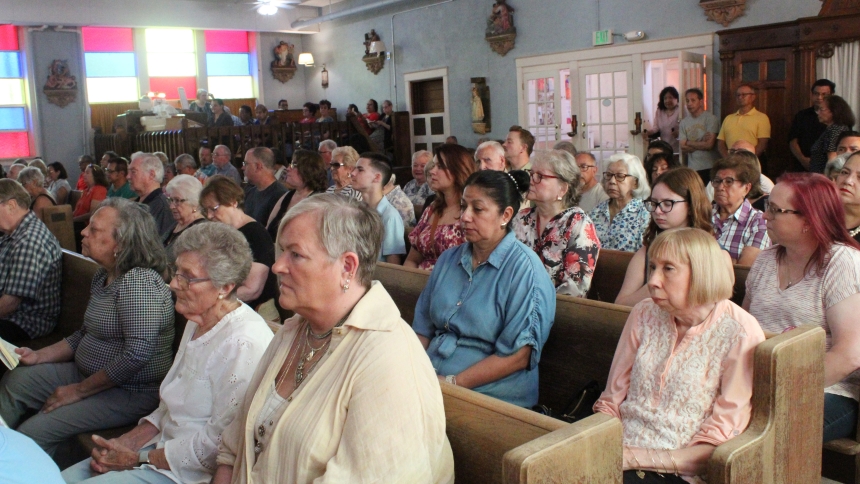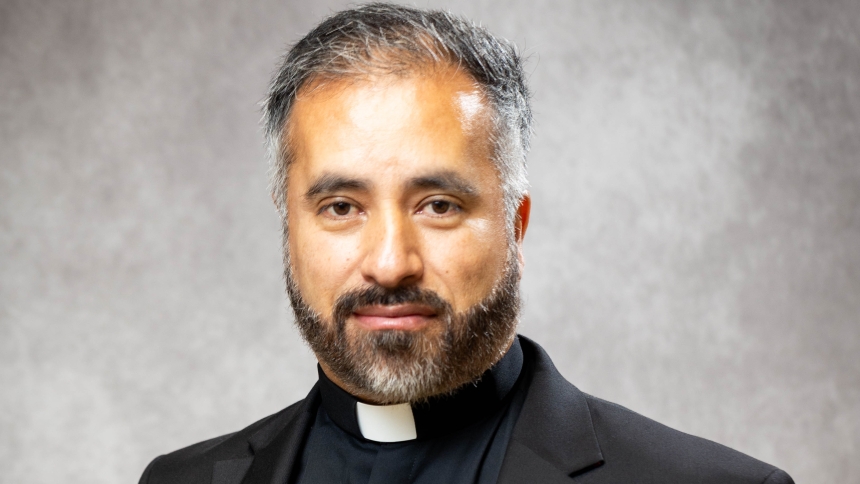
EAST CHICAGO – The legacy of Holy Trinity Croatian is not represented by a building, Bishop Robert J. McClory told past and present parishioners at the parish’s closing Mass on Aug. 10, but by the people who worshipped God and served their community for the past 109 years.
“The Lord has accomplished many great things here, and we cherish those memories,” said the bishop, noting that the first Mass was celebrated on Nov. 12, 1916 in a neighboring church, while the first Mass in Holy Trinity Croatian’s own building was held on Christmas Eve 1917.
Bishop McClory acknowledged that many past and present parishioners have strong feelings about the closing of their home church, part of the Diocese of Gary’s pastoral plan for the Northlake Deanery. “It’s okay to have a range of emotions, it’s okay to feel a sense of celebration and completion … it’s okay to be still hurting and confused, sorting out the pain of that loss.
“What I’m not going to allow is for people to think this (closing) represents a failure in any way,” said the bishop, adding that “all who came through these doors were touched on their pilgrim path.”
The bishop began his homily by reminding the standing-room-only congregation that the Catholic Church is celebrating a Jubilee Year in 2025 with the theme “Pilgrims of Hope.”
Pilgrims “start at one place and are headed to a destination,” as are the people of Holy Trinity Croatian, added the bishop. “We can reflect on the way the Lord has touched our lives as we reflect on the legacy of Holy Trinity, and can also look to the future.”
Referring to the hope reflected in the day’s Scripture reading from Hebrews 11, the bishop noted that, “By faith Abraham obeyed when he was called to go out to a place that he was to receive as an inheritance; he went out, not knowing where he was to go.”
Hope is “evidence of things not seen, a future that we don’t see,” said the bishop, and hope led Abraham to trust in God as he was “looking forward to a city without architecture, made by God … our churches are windows into our eternal homeland, heaven.”
Bishop McClory said the closing of Holy Trinity “is a time to give thanks to the Lord …know(ing) the ultimate treasure is heaven, our ultimate homeland. This building in which we’ve worshipped for over 100 years points us to the greatest of treasures.”
The Holy Trinity church building, which also housed the parish grade school from 1918 through 1992, was first proposed in 1910, and funds were collected for several years before construction began after Bishop Herman Alerding of the Diocese of Fort Wayne named Father Joseph A. Judnic as the first pastor in 1916.
In 1918, with an enrollment of 140, Holy Trinity grade school opened and the parish reported 74 baptisms, 29 funerals and 15 marriages out of 200 families representing 1,500 parishioners.
In the next few years, three members of the Sister Adorers of the Most Precious Blood arrived as teachers, a convent was built, the Founders Bell was dedicated and Father Francis Bahoric and Father Francis Podgorsek succeeded Father Judnic as pastors.
Father Paul Peter Bogovich arrived as assistant to the parish in 1941, with Father Podgorsek in failing health. After he died on Feb. 1, 1946, Father Bogovich was named acting pastor. A Croatian Center Hall was added in 1955, and renovations to the church continued in the 1950s.
With the installation of Bishop Andrew G. Grutka as the first bishop of the new Diocese of Gary in 1957, Father Bogovich was appointed the first presiding judge of the diocesan court, became the first vicar of East Chicago and served as a consultor to the bishop for 13 years.
After Msgr. Bogovich died on June 2, 2002, Holy Trinity having been his only pastorate, Father Stanley Dominik became vicar general and Northlake Deanery head for the diocese, and a number of visiting priests helped out with Masses at Holy Trinity. Father Terrance Steffens was named administrator in residence by Bishop Donald J. Hying in 2016.
A $400,000 grant from Foundations of East Chicago in 2017 helped make a number of renovations to the only church building Holy Trinity has ever known.
“Today is bittersweet,” admitted Sandra Rosas, a Holy Trinity Croatian parishioner for 32 years who added that her children flew in from their current homes to attend the final Mass.
Melissa Alvarado Quasney, now of Crown Point, said she attended Holy Trinity grade school, graduating in 1982, and fondly recalls sitting with her class and singing hymns at school Masses celebrated by Msgr. Bogovich. “He baptized us,” she added.
Cynthia Rivas, religious education co-director with Carmen Vasquez, also has fond memories of Holy Trinity School. “My son graduated in the last class, and we joined the Home and School Association,” she said.
Rose Antich Smith lived “right across the street from the church” growing up and graduating from Holy Trinity School in 1958. “The nuns were very much a part of our lives and didn’t put up with any monkey business,” recalled Smith, who married her husband of 58 years, Olan Smith, at the church. The couple now live in Iowa, but returned to East Chicago for the closing Mass.
“Msgr. Bogovich told me to ‘be good to her’ on our wedding day,” remembered Olan Smith, who admitted sharing an occasional cigar with the longtime pastor.
Parochial Coordinator Angela Petrunich said she believes the legacy of Holy Trinity Croatian will be “the people, because they are what made this parish special. The rest is just sentimental stuff.”
“There’s immense sadness in knowing one’s spiritual home is transitioning,” said Father Jeff Burton, dean of north Lake County’s parishes and pastor/administrator for three parishes and two schools. “For Catholics in particular, our church buildings are where we’re baptized, where we come to know Christ in the Eucharist, where people are wed and where we say that earthly farewell to those we love. At the same time, statistically, fewer Catholics are celebrating those milestones in our churches and fewer are in the pews every Sunday.”
Father Burton noted that priestly retirements are outpacing ordinations, which impacts parish resources. “I’m currently shepherding three parishes, two of which have grade schools, chaplaining our largest high school and holding other diocesan responsibilities,” he explained. “Thirty years ago, there were 11 priests doing what I do today.”
Last year, Bishop McClory commissioned a team to discern a plan to provide for the ongoing spiritual and pastoral care of the Catholic faithful in Hammond, Whiting and East Chicago. Pastors of 14 parishes appointed three parishioners each who, with the clergy, collaborated during three months to consider a path forward. Parishioners were invited to two open sessions at Bishop Noll Institute to ask questions and provide input.
Twenty-one models were proposed and the key leaders selected four of them to evaluate, eventually recommending one of them to the bishop last December. The bishop accepted their recommendation in a letter dated May 11, proposing to use the next several years to transition to a four-parish model with three additional worship sites in northern Lake County.
In East Chicago, the main parish will be St. Mary, with an additional worship site at Our Lady of Guadalupe. In Hammond, the main parishes will be St. Casimir and St. John Bosco, with additional worship sites at Our Lady of Perpetual Help and St. Margaret Mary. St. John the Baptist will be the Whiting parish.
Caption: Past and present parishioners from as close as across Carey Street to as far as California gathered to fill Holy Trinity Croatian at the East Chicago parish’s closing Mass on Aug. 10. “Our churches are windows into our eternal homeland, heaven,” Bishop Robert J. McClory, celebrant, told the gathering. (Marlene A. Zloza photo)



